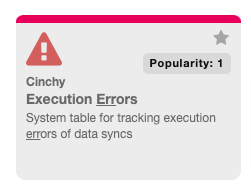Real-time sync example
Overview
This example will take you through the creation and execution of a real-time data sync where data will be synced between two Cinchy tables based on real-time changes.
Use case
Your People table captures a view of various personnel information. Any time a new hire is added to the table, you want that information to be immediately synced into the New Employees table. We can solve this use case using the Cinchy Change Data Capture (CDC) function on our tables. This helps you to better keep track of all incoming people within your company.
Sample files and code
This section has steps on how to:
- Create the People table.
- Create the New Employees table.
When you create tables to use with real-time syncs, make sure you turn on the Cinchy Change Data Capture feature through the Design Table > Change Notifications tab. This makes sure you capture real-time updates.
People table creation
-
Login to your Cinchy platform.
-
From under My Network, click the Create > Standard Table > From Scratch.
-
Create a table with the following properties (Image 1):
Table Details Values Table Name People Icon + Colour Default Domain Sandbox infoIf this domain doesn't exist, either create it or make sure to update this parameter where required during the data sync.

-
Click Columns in the left hand navigation to create the columns for the table.
-
Click the "Click Here to Add" button and add the following columns:
| Column Details | Values |
|---|---|
| Column 1 | Column Name: Name |
| Data Type: Text | |
| Column 2 | Column Name: Title |
| Data Type: Text | |
| Column 3 | Column Name: Phone Number |
| Data Type: Text | |
| Column 4 | Column Name: City |
| Data Type: Text |
- Select Change Notifications in the left hand navigation and select Publish Change Notifications.
- Select Save to save your table.
New Employees table creation
- Within the Cinchy platform, from under My Network, select Create
- Select Table
- Select From Scratch
- Create a table with the following properties (Image 2):
| Table Details | Values |
|---|---|
| Table Name | New Employees |
| Icon + Colour | Default |
| Domain | Sandbox (if this domain doesn't exist, either create it or make sure to update this parameter where required during the data sync) |
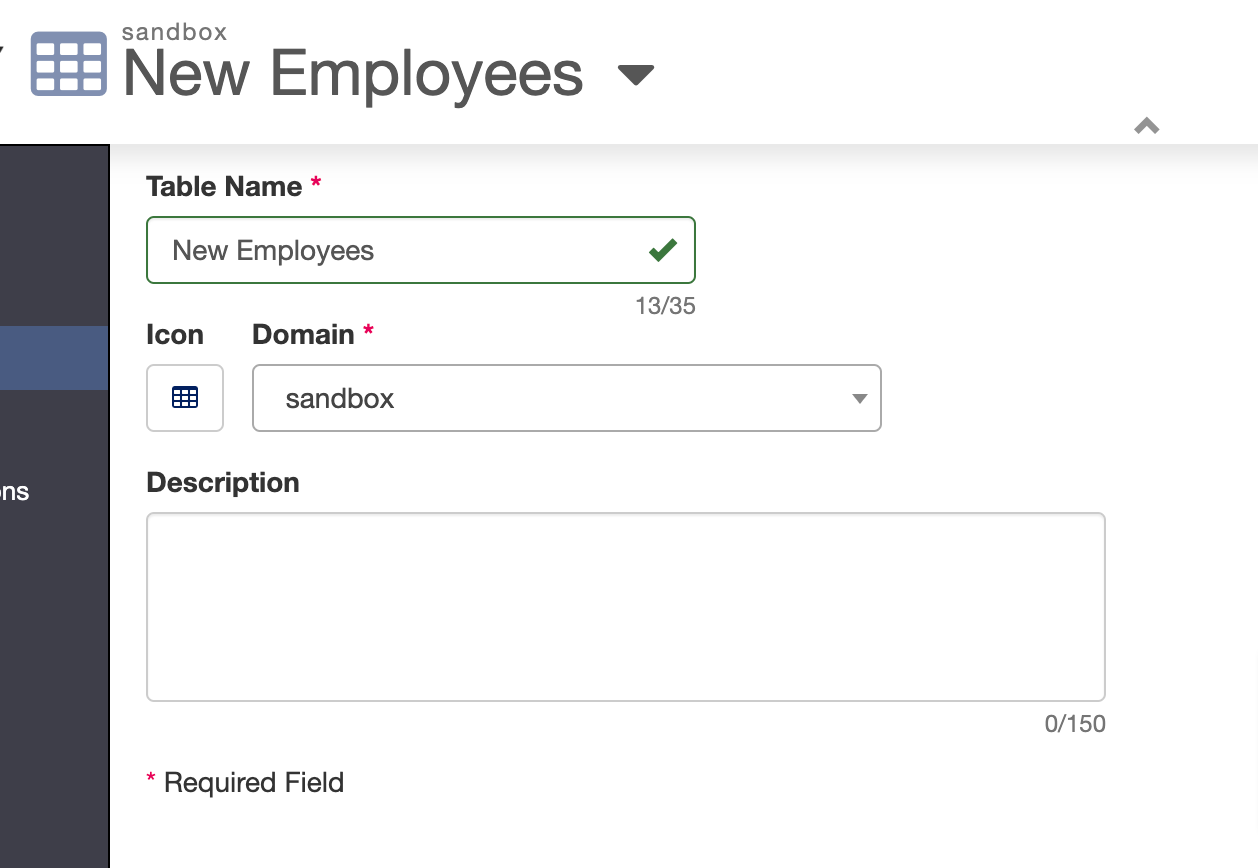
-
Select Columns in the left hand navigation to create the columns for the table.
-
Select the "Click Here to Add" button and add the following columns:
| Column Details | Values |
|---|---|
| Column 1 | Column Name: Name |
| Data Type: Text | |
| Column 3 | Column Name: Title |
| Data Type: Text |
- Click the Save button to save your table.
Create the data sync
You have two options when you create a data sync in Cinchy.
- You can input all the necessary information through the Connections UI. Once saved, this data uploads as an XML file into the Data Sync configurations table.
- You can bypass the UI and upload your XML config directly into the Data Sync configuration table yourself.
This example will walk you through both options.
Use the Connections UI
- Within your Cinchy platform, navigate to the Connections Experience (Image 3).
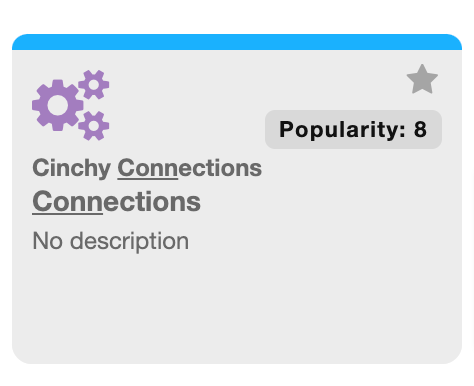
- In the Info tab, input the name of your data sync. This example uses "New Hires" (Image 4).

Configure the source
As of 5.7, you can now configure the Topic JSON in the Source tab under the Listener section. If you still need to manually configure the Topic JSON, see the appendix for more information.
- Navigate to the Source tab.
- Under Select a Source, select Cinchy Event Broker (Image 5).
- Under Listener, select the People table.
- For Return Columns, select All.

Configure the destination
- Navigate to the Destination tab and select Cinchy Table from the drop down (Image 6).
- Click Load.
- In the Connection section, input the Domain and Table name for your destination. This example uses the Sandbox domain and the People table.
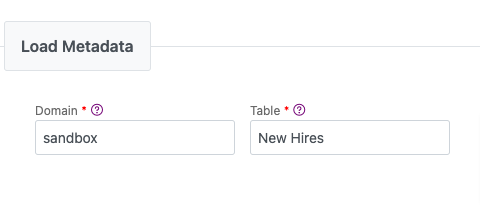
- Select the columns that you wish to use in your data sync (Image 8). These will be the columns that your source syncs to your target. This example uses the Name and Title columns. You also have many Cinchy system table available to use.
- Click Load.
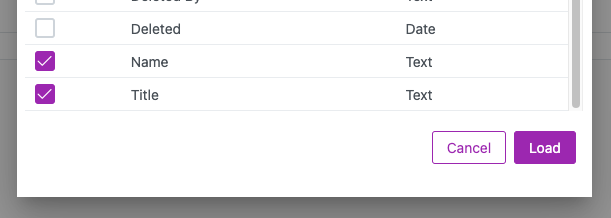
- The Connections experience will try to automatically map your source and destination columns based on matching names. In the below screenshot, it has been able to correctly match the Name and Title columns (Image 8).
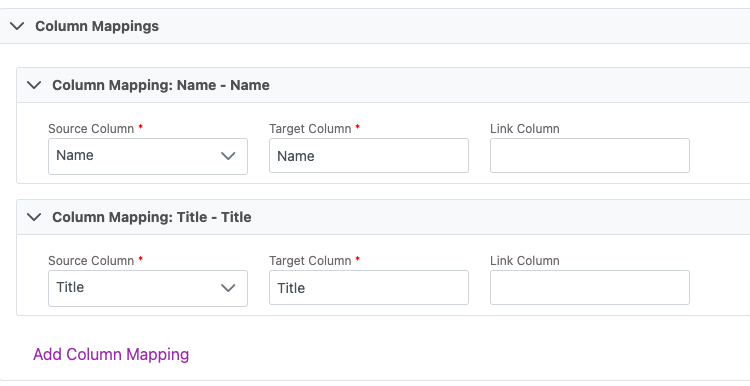
Sync actions
-
Navigate to the Sync Actions tab. Two options are available for data syncs: Full File and Delta. For this example, select Full File.
infoFull load processing means that the entire amount of data is imported iteratively the first time a data source is loaded into the data studio. Delta processing means loading the data incrementally (loading the source data at specific pre-established intervals).
-
Set the following parameters (Image 9):
| Parameter | Description | Example |
|---|---|---|
| Sync Key Column Reference | Unique key for syncing data between source and target tables. | Name |
| New Record Behaviour | Action for new records in sync source: Insert or Ignore. | Insert |
| Dropped Record Behaviour | Action for dropped records in sync source: Delete, Ignore, or Expire. | Delete |
| Changed Record Behaviour | Action for changed records in sync source: Update, Ignore, or Conditional. | Update |
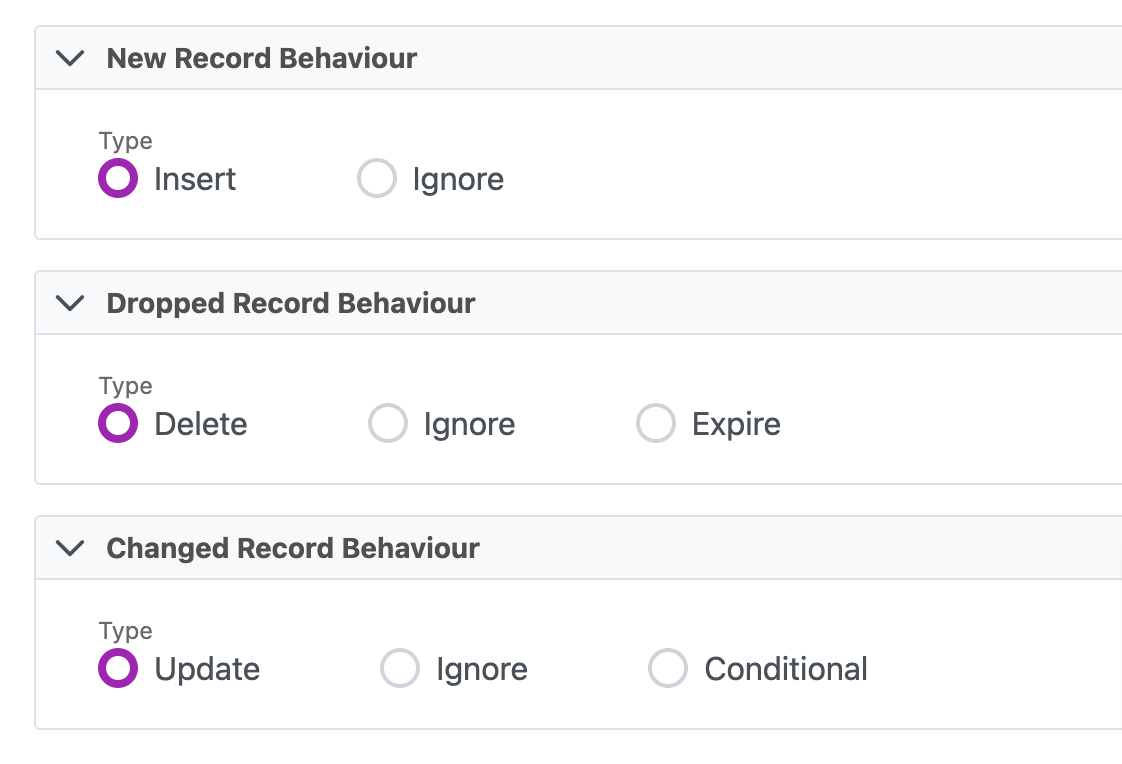
-
Navigate to the Permissions tab. Here you will define your group access controls for your data sync. You can set this how you like. This example gives all users access to Execute, Write, and Read our sync (Image 10).
infoAny groups given Admin Access will have the ability to Execute, Write, and Read the data sync.

-
Click Save.
-
Navigate to the Cinchy Listener Config table and validate your configuration. Make sure it's set to Enabled. Your real-time data sync should now be listening to your People table ready to push updates to your New Employees table.
-
Test your data sync by adding a new row to your People table. Ensure that the data is then updated across to the New Employees table (Images 11 & 12).
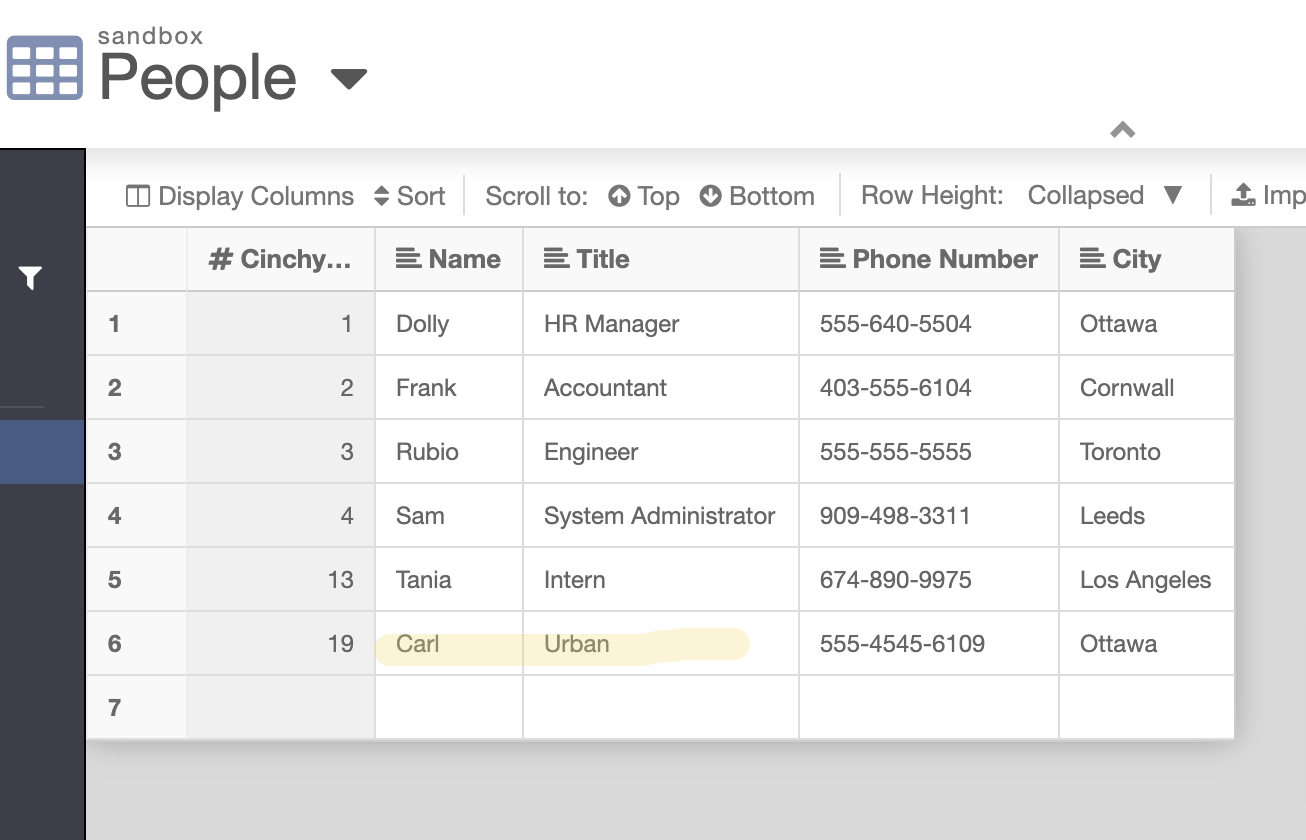
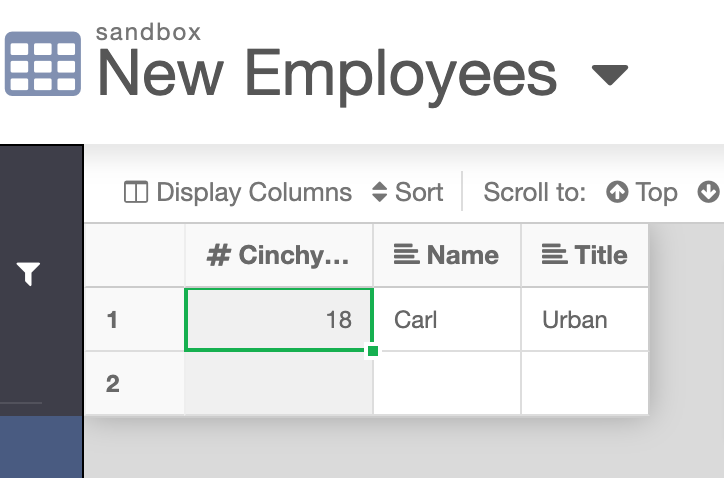
Use a data sync XML
Instead of using the Connections UI, you can also set up a data sync by uploading a correctly formatted XML into the Data Sync Configs table within Cinchy.
We only recommend doing so once you have a good understanding of how data syncs work. Not all sources and targets follow the same XML pattern.
Blank XML example
The below XML shows what a blank data sync could look like for our Cinchy Event Broker/CDC to Cinchy Table real-time sync with full file synchronization.
<?xml version="1.0" encoding="utf-16"?>
<BatchDataSyncConfig name="" version="1.0.0" xmlns="http://www.cinchy.co">
<CinchyEventBrokerDataSource runQuery="false">
<Schema>
<Column name="" dataType="" trimWhitespace="true" isMandatory="false" validateData="false"/>
</Schema>
</CinchyEventBrokerDataSource>
<CinchyTableTarget reconcileData="true" domain="" table="" suppressDuplicateErrors="false" degreeOfParallelism="1">
<ColumnMappings>
<ColumnMapping sourceColumn="" targetColumn=""/>
</ColumnMappings>
<SyncKey readonly="false">
<SyncKeyColumnReference name=""/>
</SyncKey>
<NewRecordBehaviour type=""/>
<DroppedRecordBehaviour type=""/>
<ChangedRecordBehaviour type=""/>
<PostSyncScripts/>
</CinchyTableTarget>
</BatchDataSyncConfig>
Filled XML example
The below filled XML example matches the Connections UI configuration made in Use the Connections UI . You can review the parameters used in the table below.
| Parameter | Description | Example |
|---|---|---|
| Name | Name of the data sync | New Hires |
| Column Name | Source column names for sync | "Name", "Title" |
| Column Data Type | Data type of source columns | "Text" |
| Domain | Cinchy target table domain | Sandbox |
| Table | Cinchy target table name | New Employees |
| Column Mapping Source Column | Source columns for sync | "Name", "Title" |
| Column Mapping Target Column | Target column names mapped to source | "Name", "Title" |
| Sync Key Column Reference Name | Unique key for syncing data between source and target | "Name" |
| New Record Behaviour Type | Action for new records in source | INSERT |
| Dropped Record Behaviour Type | Action for dropped records in source | DELETE |
| Changed Record Behaviour Type | Action for changed records in source | UPDATE |
<?xml version="1.0" encoding="utf-16"?>
<BatchDataSyncConfig name="New Hires" version="1.0.0" xmlns="http://www.cinchy.co">
<CinchyEventBrokerDataSource runQuery="false">
<Schema>
<Column name="Name" dataType="Text" trimWhitespace="true" isMandatory="false" validateData="false"/>
<Column name="Title" dataType="Text" trimWhitespace="true" isMandatory="false" validateData="false"/>
</Schema>
</CinchyEventBrokerDataSource>
<CinchyTableTarget reconcileData="true" domain="sandbox" table="New Employees" suppressDuplicateErrors="false" degreeOfParallelism="1">
<ColumnMappings>
<ColumnMapping sourceColumn="Name" targetColumn="Name"/>
<ColumnMapping sourceColumn="Title" targetColumn="Title"/>
</ColumnMappings>
<SyncKey readonly="false">
<SyncKeyColumnReference name="Name"/>
</SyncKey>
<NewRecordBehaviour type="INSERT"/>
<DroppedRecordBehaviour type="DELETE"/>
<ChangedRecordBehaviour type="UPDATE"/>
<PostSyncScripts/>
</CinchyTableTarget>
</BatchDataSyncConfig>
Use the data sync XML
- Once you have completed your Data Sync XML, navigate to the Data Sync Configurations table in Cinchy (Image 13).
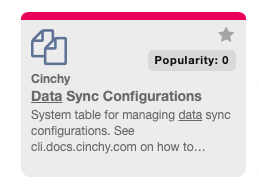
- In a new row, paste the Data Sync XML into the Config XML column.
- Define your group permissions in the applicable columns. This example gives All Users the Admin Access.
The Name and Config Version columns will be auto populated as they values are coming from the Config XML.
Be sure when you are pasting into the Config XML column that you double click into the column before pasting, otherwise each line of the XML will appear as an individual record in the Data Sync Configurations table.
- Navigate to the Cinchy Listener Config table and set up your configuration. Ensure it's set to Enabled. Your real-time data sync should now be listening to your People table ready to push updates to your New Employees table.
- To execute your Data Sync you will use the CLI. If you don't have this downloaded, refer to the CLI commands list page
- In this example we will be using the following Data Sync Commands.
| Parameter | Description | Example |
|---|---|---|
| -s (server) | Required. The full path to the Cinchy server without the protocol (cinchy.co/Cinchy). | "pilot.cinchy.co/Training/Cinchy/" |
| -u (user id) | Required. The user id to login to Cinchy that has execution access to the data sync. | "admin" |
| -p (password) | Required. The password of the above User ID parameter. This can optionally be encrypted. For a walkthrough on how to use the CLI to encrypt the password, refer to the Appendix section. | "DESuEGqfffsamx55yl256hjuPYxa4ncc+5+bLkoVIFpgs0Lq6hkcU=" |
| -f (feed) | Required. The name of the Data Sync Configuration as defined in Cinchy | "Contact Import" |
- Launch PowerShell and navigate to the Cinchy CLI directory.
- Enter and execute the following into PowerShell:
.\Cinchy.CLI.exe syncdata -s "pilot.cinchy.co/Training/Cinchy/" -u "admin" -p "DESuEGqmx55yl2PYxa4ncc+5+bLkoVIFpgs0Lq6hkcU=" -f "Contact Import"
- Test your data sync by adding a new row to your People table. Ensure that the data is then updated across to the New Employees table (Images 14 & 15).
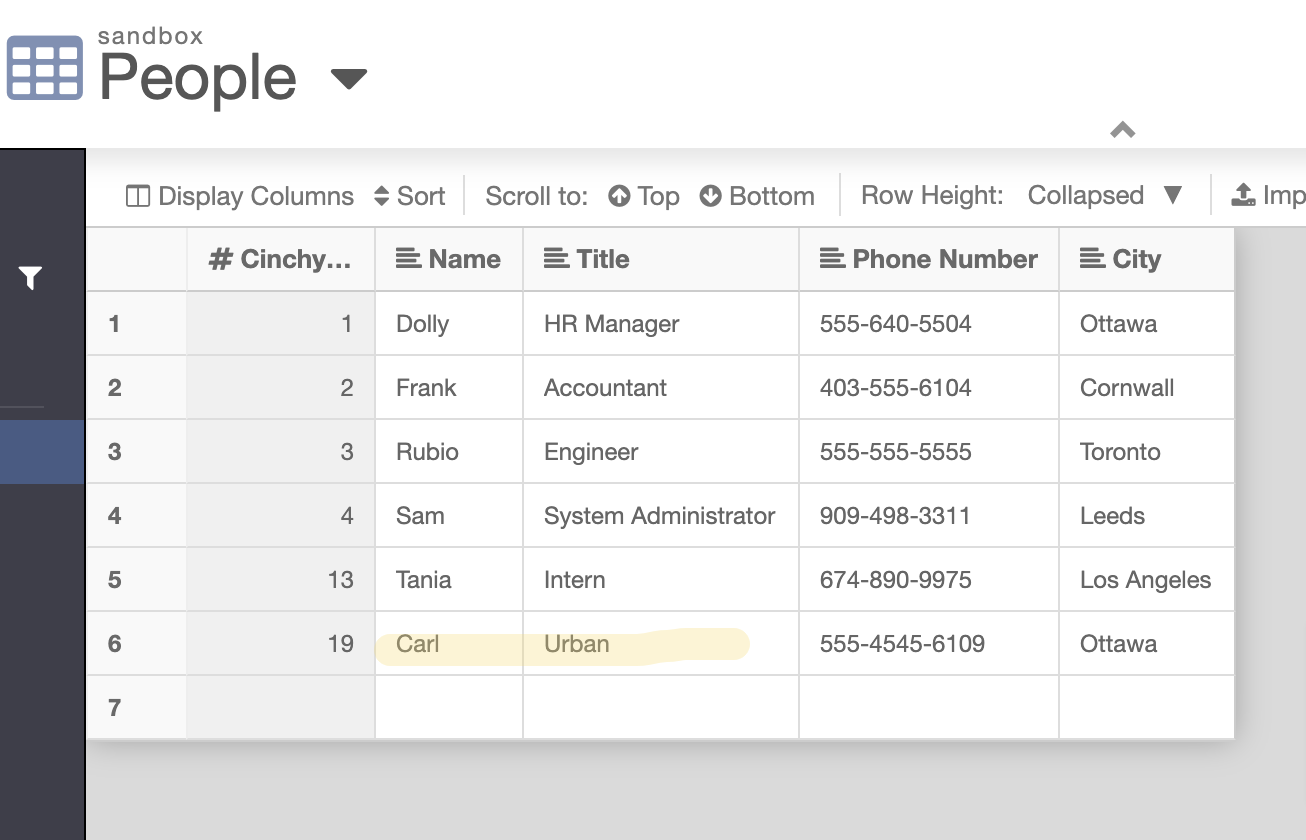

Appendix
Manually set the listener config
This section provides information on how to manually set up the listener config using the Listener Config table. While this example shows how to configure the sync using the Cinchy Event Broker/CDC, Cinchy also supports other Event Stream Sources. For more information, see the supported real-time sync stream sources.
- Navigate to the Listener Config table in Cinchy (Image 16).
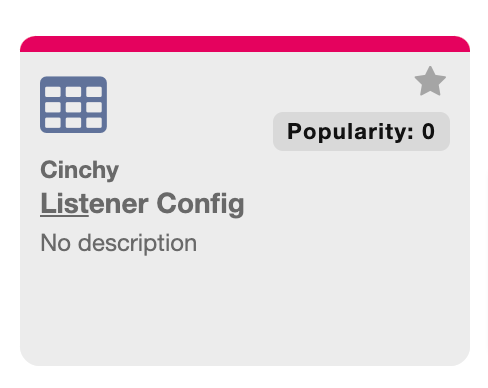
- In a new row, add in your listener config data using the below table as a guide:
| Column | Description | Example |
|---|---|---|
| Name | The name of your Listener Config | New Hire Sync |
| Event Connector Type | Select from the drop-down list which event stream you are listening in on. | Cinchy CDC |
| Topic | This column expects a JSON value with certain specific information. Please review the Topic Column table below for details. | { "tableGuid": "3daba5da-5e07-4d35-8d7c-d451a2c9068e", "fields": [ { "column": "Name" }, { "column": "Title" } ], } |
| Connection Attributes | This section isn't required for data syncs using the Cinchy Event Broker/CDC, so we can just enter {} | {} |
| Status | This sets where your config is Enabled or Disabled. You can leave this blank until you want to turn on your config. | |
| Data Sync Config | The name of the Data Sync Config you created in the Connections UI or via XML. | New Hires |
| Auto Offset Reset | In the case where the listener is started and either there is no last message ID, or when the last message ID is invalid (due to it being deleted or it's just a new listener), it will use this column as a fallback to determine where to start reading events from. Earliest will start reading from the beginning on the queue. Latest will fetch the last value after whatever was last processed. None won't read start reading any events. | Latest |
|
Topic JSON example
{
"tableGuid": "3daba5da-5e07-4d35-8d7c-d451a2c9068e",
"fields": [
{
"column": "Name"
},
{
"column": "Title"
}
]
}
Password Encryption
Before executing the data sync command, encrypt the password using PowerShell.
To encrypt a password using PowerShell, complete the following:
- Launch PowerShell and navigate to the Cinchy CLI directory (note, you can always type PowerShell in the windows explore path for the Cinchy CLI directory).
- Enter the following into PowerShell
.\Cinchy.CLI.exe encrypt -t "password". - Hit enter to execute the command.
- Copy the password so you have it accessible at batch execution time.
You will need to replace password with your specific password.
Execution logs
The Execution Log table is a system table in Cinchy that logs the outputs of all data syncs. You can always review the entries in this table for information on the progression of your syncs (Image 17).
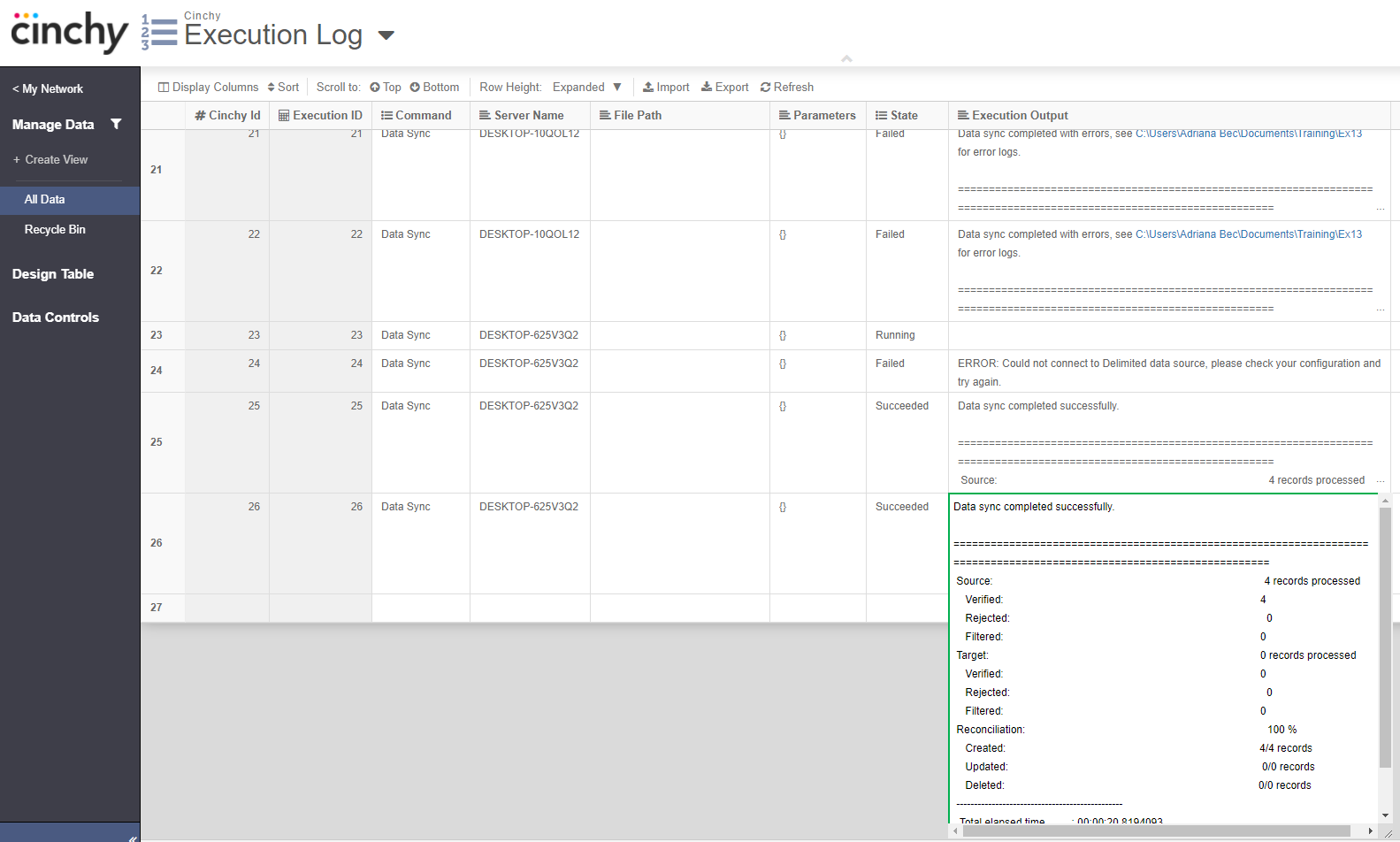
Execution errors
The Execution Errors table is a system table in Cinchy that logs any errors that may occur in a data sync (Image 18). Any data sync errors will also be logged in the temp directory outlined in the data sync execution command (-d "C:\Cinchy\temp")
